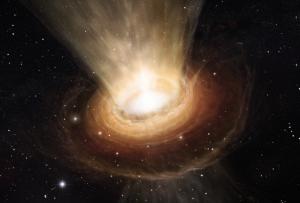Blog
Hole in One
1 June 2014
 ESO/M. Kornmesser
ESO/M. KornmesserRecently there’s been news that scientists suspect the black hole in the center of our galaxy may be a wormhole instead. Needless to say, you shouldn’t get your hopes up. The news is actually based on an article published in Physical Review D that outlines how one might distinguish between a black hole and a hypothetical “white hole”.1
Wormholes are an idea that show up every now and then in the literature. They originally appeared as an extension of black hole solutions past the singularity as a kind of misguided mathematics. They were originally known as Einstein-Rosen bridges, but it didn’t take long for the term “wormhole” to become popular. Technically, they are a possible solution within general relativity, but theoretical studies soon showed there was no way for them to be traversable without some kind of “exotic matter”. Later it was found that some theoretical extensions of general relativity could allow for wormholes without exotic matter, so there’s been some work to determine whether they would have any visible effect.
Basically that’s the topic of this particular paper. The authors start by supposing that wormholes can exist through some extension of general relativity, and then ask whether this is some way to distinguish between an ordinary black hole and a wormhole. What they find is that the mouth of a wormhole (a white hole) would look very similar to a rotating black hole, but the way it affects material near it would be different. Basically the frame dragging effects are different. This means that any hot gases near a black hole or white hole would be distorted in different ways.
By itself, the paper is simply a “what if” scenario where theorists push the limits of a theory to better understand different models. But in this case the authors note that the resolution needed to distinguish between these two models is something achievable for the supermassive black hole in the center of the Milky Way. In a couple years the Very Large Telescope Interferometer (VLTI) will begin its GRAVITY project, which will utilize adaptive optics, and this could give us enough detail to distinguish between a black hole and a white hole.
No one seriously thinks the supermassive black hole in our galaxy is actually a wormhole, or even that wormholes are actually possible. But it’s interesting to see that such a wild idea could be testable in a few years.
Li, Zilong, and Cosimo Bambi. “Distinguishing black holes and wormholes with orbiting hot spots.” Physical Review D 90.2 (2014): 024071. ↩︎